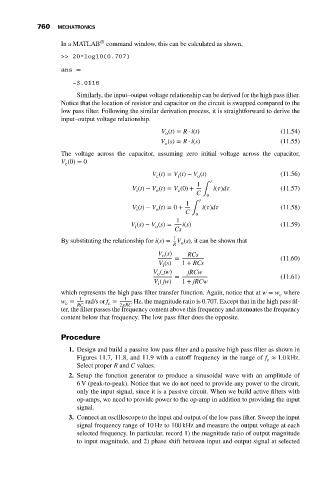Page 774 - Mechatronics with Experiments
P. 774
760 MECHATRONICS
®
In a MATLAB command window, this can be calculated as shown,
>> 20*log10(0.707)
ans =
-3.0116
Similarly, the input–output voltage relationship can be derived for the high pass filter.
Notice that the location of resistor and capacitor on the circuit is swapped compared to the
low pass filter. Following the similar derivation process, it is straightforward to derive the
input–output voltage relationship.
V (t) = R ⋅ i(t) (11.54)
o
V (s) = R ⋅ i(s) (11.55)
o
The voltage across the capacitor, assuming zero initial voltage across the capacitor,
V (0) = 0
c
V (t) = V (t) − V (t) (11.56)
o
c
i
t
1
V (t) − V (t) = V (0) + C ∫ i( )d (11.57)
i
c
o
t o
1
V (t) − V (t) = 0 + i( )d (11.58)
i
o
C ∫ o
1
V (s) − V (s) = i(s) (11.59)
i
o
Cs
1
By substituting the relationship for i(s) = V (s), it can be shown that
R o
V (s)
o RCs
= (11.60)
V (s) 1 + RCs
i
V ( jw) jRCw
o
= (11.61)
V ( jw) 1 + jRCw
i
which represents the high pass filter transfer function. Again, notice that at w = w where
c
1 1
w = RC rad/s or f = 2 RC Hz, the magnitude ratio is 0.707. Except that in the high pass fil-
c
c
ter, the filter passes the frequency content above this frequency and attenuates the frequency
content below that frequency. The low pass filter does the opposite.
Procedure
1. Design and build a passive low pass filter and a passive high pass filter as shown in
Figures 11.7, 11.8, and 11.9 with a cutoff frequency in the range of f ≈ 1.0kHz.
c
Select proper R and C values.
2. Setup the function generator to produce a sinusoidal wave with an amplitude of
6 V (peak-to-peak). Notice that we do not need to provide any power to the circuit,
only the input signal, since it is a passive circuit. When we build active filters with
op-amps, we need to provide power to the op-amp in addition to providing the input
signal.
3. Connect an oscilloscope to the input and output of the low pass filter. Sweep the input
signal frequency range of 10 Hz to 100 kHz and measure the output voltage at each
selected frequency. In particular, record 1) the magnitude ratio of output magnitude
to input magnitude, and 2) phase shift between input and output signal at selected

